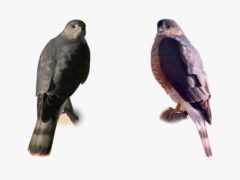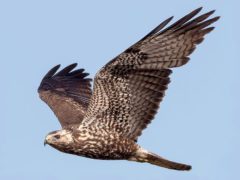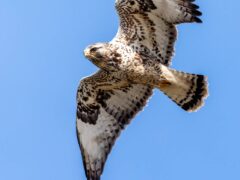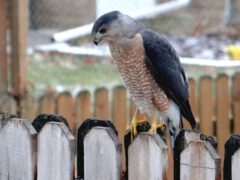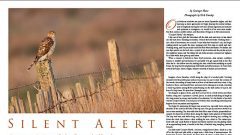Cooper's Hawk Photo Gallery
Adult
Upright posture with a long tail. Bluish-gray upperparts with a contrasting black cap and a red eye. Underparts are pale with dense reddish barring. Bill is fairly small and strongly hooked.
© Evan Lipton / Macaulay LibraryRhode Island, February 11, 2017Adult
Bluish-gray upperparts contrast with the paler cheek and dark cap. Note the long rounded tail with a wide white terminal band.
© County Lister Brendan / Macaulay LibraryMichigan, January 17, 2021Adult
Adult Cooper's Hawks have gray backs, reddish-barred chests, and reddish eyes. Note the sharp division between the black cap and gray nape (neck).
© DAVID BROWN / Macaulay LibraryNew York, April 01, 2005Not all videos have soundImmature
Immature has brown upperparts, white underparts with brown streaking, and yellow eyes.
© Brian Sullivan / Macaulay LibraryCalifornia, November 04, 2017Immature
Immature is brownish above, and like adults, has a large head and long, banded tail.
© Michael Schijf / Macaulay LibraryUtah, October 02, 2020Adult
Accipiters like Cooper's Hawk have rounded wings and very long tails. In flight, look for Cooper's Hawk's large head that projects out ahead of the wings. The long tail often appears slightly rounded at the tip.
© Larry Arbanas / Macaulay LibraryArizona, May 05, 2006Not all videos have soundImmature
Upright posture with a long tail. Immatures have brown upperparts that contrast with white underparts that have strong brown streaking. Note the yellow eye.
© Mason Maron / Macaulay LibraryWashington, September 01, 2019Adult
In flight shows relatively short, rounded wings and a long, rounded tail with thick bands. Note that its head projects well beyond its wings.
© Alex Lamoreaux / Macaulay LibraryMinnesota, October 10, 2016Adult
Note the very long tail compared to the wings—a distinctive feature of accipiters. The sharp black cap contrasting with the gray nape is a good ID feature for Cooper's Hawk.
© DAVID BROWN / Macaulay LibraryNew York, April 01, 2005Not all videos have soundImmature
In flight shows relatively short, rounded wings and a long, rounded tail with thick bands. Note the wide white terminal band on tail, which can sometimes help with identification.
© Jean-Sébastien Mayer / Macaulay LibraryQuebec, September 12, 2016Immature
In flight from above, upperparts on immatures are brown with paler barring in the wings and tail. Note the larger head that sticks out well beyond the wings.
© Byron Stone / Macaulay LibraryTexas, November 26, 2016Adult with prey
Accipiters are specialist predators that eat mostly birds. They sometimes hunt at backyard feeders.
© Timothy Barksdale / Macaulay LibraryMissouri, March 28, 1997Not all videos have soundAdult
From some angles white undertail contrasts with the reddish barred underparts and bluish-gray upperparts.
© Ryan Schain / Macaulay LibraryMassachusetts, December 06, 2016Compare with Similar Species
Click on an image to compare
Species in This Family
Hawks, Eagles, and Kites(Order: Accipitriformes, Family: Accipitridae)






















